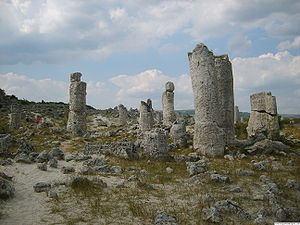
Pobiti Kamani
Encyclopedia

Rock formation
This is a list of rock formations that include isolated, scenic, or spectacular surface rock outcrops. These formations are usually the result of weathering and erosion sculpting the existing rock...
located in Varna Province, Bulgaria
Bulgaria
Bulgaria , officially the Republic of Bulgaria , is a parliamentary democracy within a unitary constitutional republic in Southeast Europe. The country borders Romania to the north, Serbia and Macedonia to the west, Greece and Turkey to the south, as well as the Black Sea to the east...
, on the road between Varna
Varna
Varna is the largest city and seaside resort on the Bulgarian Black Sea Coast and third-largest in Bulgaria after Sofia and Plovdiv, with a population of 334,870 inhabitants according to Census 2011...
and Sofia
Sofia
Sofia is the capital and largest city of Bulgaria and the 12th largest city in the European Union with a population of 1.27 million people. It is located in western Bulgaria, at the foot of Mount Vitosha and approximately at the centre of the Balkan Peninsula.Prehistoric settlements were excavated...
around several villages just west of Varna. It consists of several groups of natural rock formations on a total area of 70 km². The formations are mainly stone columns between 5 and 7 metres high and from 0.3 to 3 metres thick. The columns do not have solid foundations, but are instead hollow and filled with sand, and look like they are stuck into the surrounding sands, which gives the phenomenon its name.
In order to be preserved, Pobiti Kamani was designated a natural landmark in 1937.
There are a number of theories regarding the phenomenon's origin, divided roughly into two groups — supporting an organic or a mineral origin. According to the former, the formations are the result of coral
Coral
Corals are marine animals in class Anthozoa of phylum Cnidaria typically living in compact colonies of many identical individual "polyps". The group includes the important reef builders that inhabit tropical oceans and secrete calcium carbonate to form a hard skeleton.A coral "head" is a colony of...
activity, while the latter explain the phenomenon with the prismatic weathering of the rocks, the formation of sand and limestone
Limestone
Limestone is a sedimentary rock composed largely of the minerals calcite and aragonite, which are different crystal forms of calcium carbonate . Many limestones are composed from skeletal fragments of marine organisms such as coral or foraminifera....
concretion
Concretion
A concretion is a volume of sedimentary rock in which a mineral cement fills the porosity . Concretions are often ovoid or spherical in shape, although irregular shapes also occur. The word 'concretion' is derived from the Latin con meaning 'together' and crescere meaning 'to grow'...
s, or lower Eocene
Eocene
The Eocene Epoch, lasting from about 56 to 34 million years ago , is a major division of the geologic timescale and the second epoch of the Paleogene Period in the Cenozoic Era. The Eocene spans the time from the end of the Palaeocene Epoch to the beginning of the Oligocene Epoch. The start of the...
bubbling reefs.
Based on field observations and a petrographic and stable isotope geochemical study, evidence now exists that these structures represent an exceptionally well exposed paleo-hydrocarbon seep system (strongly depleted carbon isotope signatures of the dominant low magnesium calcite cement). The dynamic reconstruction of the origin of these structures, the processes of fluid migration and possible microbial interference in the process of carbonate precipitation are presently under study by researchers from the Catholic University of Leuven (Eva De Boever, PhD student KULeuven, Leuven, Belgium), in collaboration with researchers from the Institute of Oceanology (Lyubomir Dimitrov, Varna, Bulgaria), RCMG (Ghent University, Belgium), the Geobiology Lab of the University of Goettingen (Volker Thiel, Goettingen, Germany) and the University of Bologna (Barbara Cavalazzi, Bologna, Italy).

